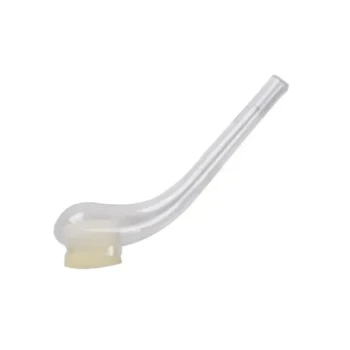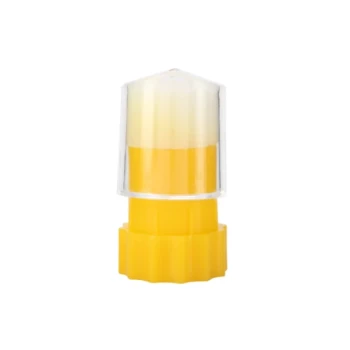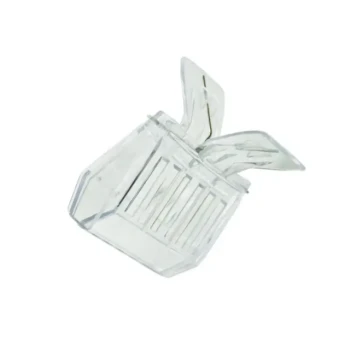A queen bee determines where to lay her eggs through a remarkable act of physical measurement. Before depositing an egg, she uses her forelegs to meticulously gauge the diameter of the honeycomb cell. This simple, tactile assessment is the critical switch that dictates whether she lays a fertilized egg (which becomes a female worker) or an unfertilized egg (which becomes a male drone).
The queen’s decision is not a conscious choice but a physical trigger based on cell size. This mechanism is the foundation of the hive's entire caste system, ensuring the colony has the right balance of workers and drones needed for its survival and reproduction.
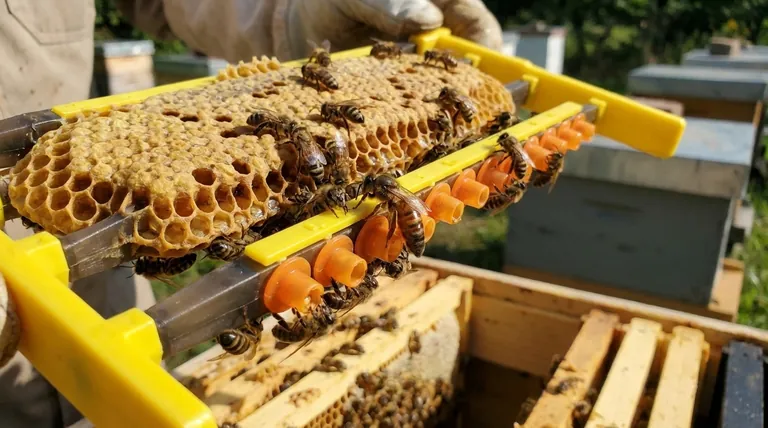
The Queen's Core Function: Building the Colony
A queen's primary role is to populate the hive. However, this is not a random process. She is a strategic egg-laying machine, and her placement is guided by the architecture the worker bees have built for her.
The Primary Mechanism: Sizing Up the Cell
When a queen approaches a cell to lay, she first inserts her head and forelegs. Her legs physically measure the width of the cell opening. This measurement directly informs the type of egg she will lay next.
Laying a Worker Bee (Fertilized Egg)
The vast majority of cells in a hive are worker cells, which are smaller in diameter. When the queen’s legs detect this smaller size, it triggers the release of sperm from her spermatheca to fertilize the egg as she lays it. This fertilized egg is diploid (containing genetic material from both the queen and a drone) and will develop into a female worker bee.
Laying a Drone (Unfertilized Egg)
Worker bees also construct larger cells known as drone cells. When the queen measures one of these larger cells, the fertilization process is inhibited. She lays an unfertilized egg, which is haploid (containing only the queen's genetic material). This egg will develop into a male drone.
The Special Case: Queen Cells
The process for creating a new queen is different. Worker bees build unique, peanut-shaped queen cells that hang vertically from the comb, unlike the horizontal worker and drone cells. The distinct shape, size, and orientation make them unmistakable to the queen, who will then lay a fertilized egg inside.
Understanding the System's Limitations
This elegant system is highly efficient but depends on a healthy queen and properly constructed comb. When these conditions aren't met, the system can fail, often with disastrous consequences for the colony.
The "Laying Worker" Problem
If a colony loses its queen and fails to raise a new one, the stress can cause some worker bees' ovaries to develop. These "laying workers" will begin to lay eggs. However, because they have never mated, they can only lay unfertilized drone eggs. Worse, they lay them in the small worker-sized cells, producing undersized and often non-viable drones, which ultimately leads to the colony's collapse.
Impact of Damaged or Irregular Comb
A queen relies on the workers to provide a proper canvas. If the honeycomb is damaged, misshapen, or poorly drawn, the queen may struggle to measure cells correctly. This can result in a spotty brood pattern, with drones laid in worker areas or the queen avoiding entire sections of the comb, hindering the colony's ability to grow.
Making the Right Choice for Your Goal
Understanding this mechanism is fundamental for any beekeeper aiming to manage a healthy, productive hive. Your management decisions directly influence the template the queen has to work with.
- If your primary focus is rapid colony growth: Ensure the hive has ample frames of worker-sized foundation so the queen can focus on producing the maximum number of worker bees.
- If your primary focus is managing the drone population: Provide a dedicated frame with drone-sized foundation, which gives you control over where drones are raised and allows for easier removal if you are managing varroa mites.
- If your primary focus is raising new queens: Recognize that you are not forcing the queen's hand; you are creating the conditions where the colony's natural impulse to build queen cells is initiated.
Ultimately, the queen's simple measurement of a cell is a masterclass in biological efficiency, translating physical space into the very structure of bee society.
Summary Table:
| Cell Type | Egg Type | Resulting Bee | Key Characteristic |
|---|---|---|---|
| Worker Cell | Fertilized | Female Worker Bee | Smaller diameter cell triggers fertilization. |
| Drone Cell | Unfertilized | Male Drone | Larger diameter cell inhibits fertilization. |
| Queen Cell | Fertilized | New Queen | Unique, vertical, peanut-shaped cell. |
Equip Your Apiary for Success with HONESTBEE
Understanding the queen's egg-laying behavior is key to managing a productive hive. The right equipment provides the foundation she needs to thrive. HONESTBEE supplies commercial apiaries and beekeeping equipment distributors with the high-quality, wholesale-priced supplies necessary to build strong, healthy colonies.
From durable frames and foundation to essential hive tools, our products are designed to support the precise conditions your bees require. Let's build a stronger hive together. Contact our wholesale experts today to discuss your apiary's needs.
Visual Guide
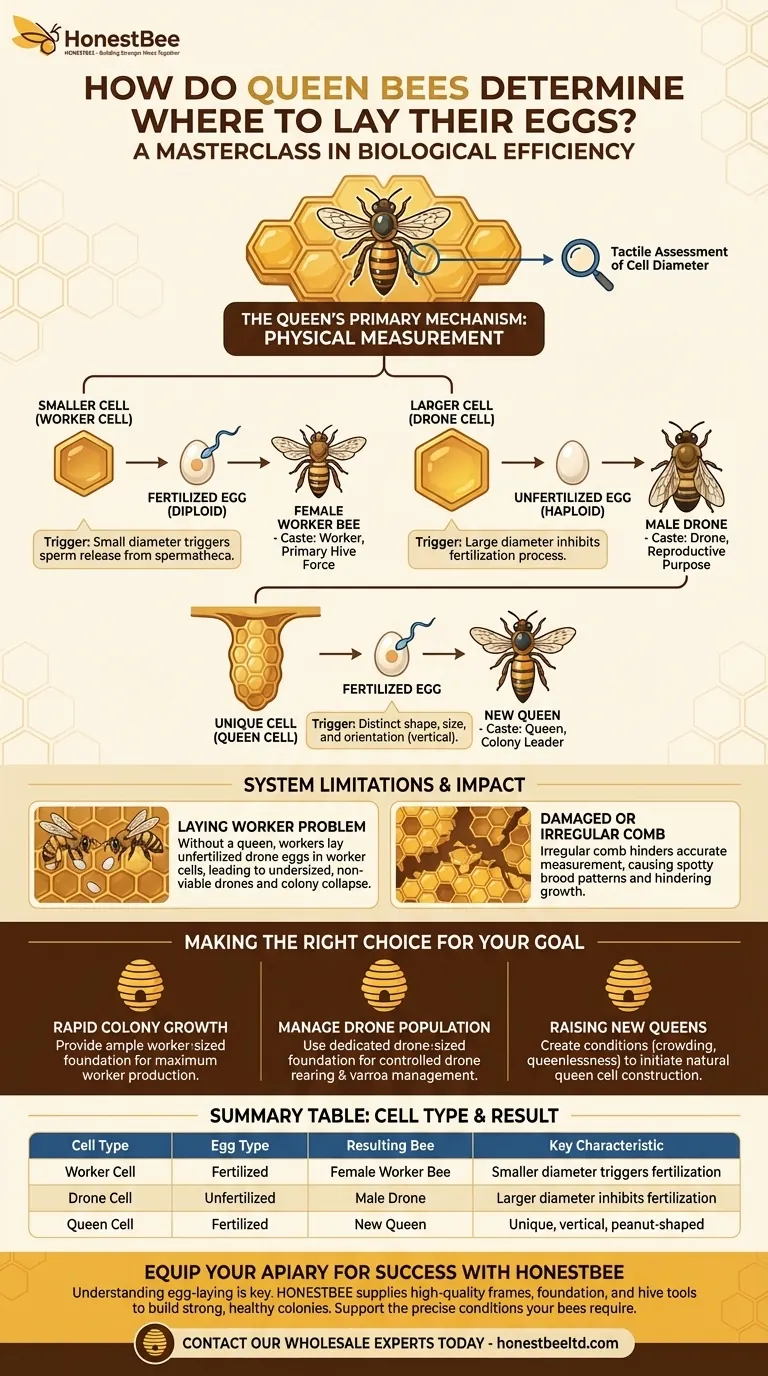
Related Products
- JZBZ Langstroth Queen Rearing Frame for Beekeeping
- Stainless Steel Queen Grafting Tool for Beekeeping and Bee Queen Grafting
- Plastic Chinese Queen Grafting Tool for Bee Queen Rearing
- Professional Queen Catcher and Introduction Queen Cage
- Queen Bee Catcher Plastic Bee Marker Bottle with Piston Marking Tube
People Also Ask
- What is the purpose of queen rearing frames? Master Controlled Queen Production for Your Apiary
- What is the timeline for queen breeding? A 28-Day Guide from Egg to Laying Queen
- What are orientation flights for virgin queens? The Essential Guide to Queen Bee Navigation
- How long can a hive survive queenless? The Critical Countdown to Save Your Colony
- What do queen rearers do with queens that fail to lay on time? The Critical Quality Control Decision



